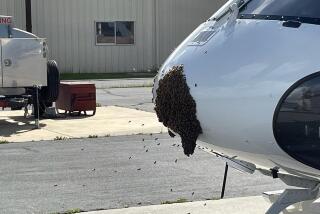Human-Powered Copter Lifts Off--Briefly
- Share via
SAN LUIS OBISPO — In what may be the first official flight of its kind, a human-powered helicopter inched off the ground here Sunday night, hovering 6 inches in the air for just over 7 seconds as cheering college students looked on.
The flight of the homemade chopper--an ungainly contraption of plastic foam, balsa wood and graphite--was achieved after eight years of effort by various teams of students at the Cal Poly here.
“This was certainly a heck of a demonstration. This definitely indicates a lift,” said Tom Steulpnagel, an official observer for the National Aeronautic Assn.
Stuelpnagel said the feat will not be declared an official record of human-powered helicopter flight, however, until after association experts in Washington review video tapes of the lift-off and verify his report, which could take several weeks.
Students cheered as Greg McNeil, a sophomore from Ojai, pedalled furiously in the craft’s sling-like seat.
A 100-foot-long rotor circled noiselessly above, as McNeil, a world-class cyclist who is aiming for a spot in the 1992 Olympics, strained at his task.
After a day-long exercise in frustration, including 10 failed attempts at lift-off, the 11th attempt succeeded.
Work on Sunday’s feat actually began in 1981, when Cal Poly engineering students accepted the American Helicopter Society’s challenge to build a human-powered helicopter capable of hovering three meters--about 10 feet--off the ground for one minute. The challenge, which included a $25,000 prize, also spurred students in Arizona, Florida, England and Japan to begin similar projects, but all have flopped.
In fact Sunday’s flight fell far short of achieving the goal. The attempt to achieve human powered helicopter flight has been going on for centuries--since the time of Leonardo da Vinci, said Sonny Darlington, coordinator for the American Helicopter Society’s contest and an engineer for Bell Helicopters in Texas. What has thwarted would-be fliers using human muscle, he said, is the tremendous amount of power needed to achieve vertical flight. Pound for pound, it requires twice as much power as an airplane’s forward flight, he said.
At Cal Poly as elsewhere, the project previously has been an exercise in frustration. The latest helicopter, named after the great Italian inventor/artist for his visionary sketches of human-powered flying machines, is the fourth in a series of choppers built here. The first stayed put, and the second and third--behemoths with wingspans of 140 feet--flipped and crashed.
McNeil lay in a seat swinging inside a triangular aluminum cage aboard the 97-pound aircraft. His pedals pulled polyethylene thread connecting the two rotating blades with propellers twirling on the edge of the blades.
McNeil already had pedaled the craft into the air twice--on Nov. 12 and Nov. 27--but needed to reenact those flights under the eyes of the NAA experts.
Although the Da Vinci III did not hover long enough or high enough Sunday to qualify for the society’s $25,000 prize, Cal Poly students will try to earn the prize with another chopper, said Neil Saike, a senior acting as the Da Vinci III’s project manager.
Meanwhile, the Da Vinci III will go into retirement.
“We may hang it on the wall and admire it, or we may give it to the Smithsonian,” Saike said.
Times staff writer Hector Tobar in Los Angeles contributed to this story
More to Read
Sign up for Essential California
The most important California stories and recommendations in your inbox every morning.
You may occasionally receive promotional content from the Los Angeles Times.













